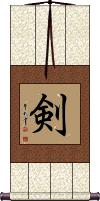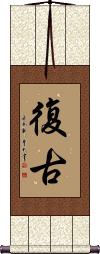Many custom options...
And formats...

Clock in Chinese / Japanese...
Buy a Clock calligraphy wall scroll here!
Personalize your custom “Clock” project by clicking the button next to your favorite “Clock” title below...
Sword
剱 is the modern Japanese way to write sword.
This Kanji character comes from original Chinese. This form would also be understood in Chinese (there are often several ways to write the same character) but I suggest this one only if your audience is Japanese (because they've settled on a slightly different form as the standard in China).
In Japanese, this character also means saber/sabre, blade, bayonet, stinger, and clock hand (clock hands are the “swords” of the clock).
See Also: Katana
Retro / Old School
The meaning of 復古 can vary depending on the context. It used to mean a return to the old ways.
It can also mean “to turn back the clock,” “retro” (fashion style based on nostalgia, esp. for the 1960s), “revival,” or “restoration.”
The return to “the old ways” was also an aspiration of Confucius about 2500 years ago. This proves that “going retro” or “old school” has been cool since at least 500 B.C.
Even a fool may sometimes come up with a good idea
千慮一得 means “1000 tries, one success,” or “[a] thousand tries [leads to] one success.”
This proverb is a humble way to express your success, ideas, or accomplishments. As if you are a fool who just got lucky in inventing or creating something.
Translations for this proverb include:
Even without any notable ability on my part, I may still get it right sometimes by good luck.
Even a fool may sometimes come up with a good idea.
Compare this to the English idiom, “Even a broken clock is right twice a day.”
These search terms might be related to Clock:
Control of Power
I Control My Own Destiny
Self-Control
Self-Restraint / Self-Control
Speed Control
Will-Power / Self-Control
Not the results for Clock that you were looking for?
Below are some entries from our dictionary that may match your Clock search...
| Characters If shown, 2nd row is Simp. Chinese |
Pronunciation Romanization |
Simple Dictionary Definition |
復古 复古 see styles |
fù gǔ fu4 gu3 fu ku fukko ふっこ |
More info & calligraphy: Retro / Old School(n,vs,vt,vi,adj-no) revival; restoration |
時 时 see styles |
shí shi2 shih tozaki とざき |
o'clock; time; when; hour; season; period (suffix noun) (1) (after noun or -masu stem of verb) (See 食事時) time for ...; time to ...; (suffix noun) (2) (See 売り時) good time to ...; opportunity to ...; (suffix noun) (3) (See 花見時) season; (surname) Tozaki Time, hour, period; constantly; as kāla, time in general, e.g. year, month, season, period; as samaya, it means kṣaṇa, momentary, passing; translit. ji. |
針 针 see styles |
zhēn zhen1 chen harisaki はりさき |
needle; pin; injection; stitch; CL:根[gen1],支[zhi1] (1) needle; pin; (2) hook; (3) stinger; thorn; (4) hand (e.g. clock, etc.); pointer; (5) staple (for a stapler); (6) needlework; sewing; (7) malice; (ctr,n-suf) (8) counter for stitches; (surname) Harisaki sūci; a needle. |
鈎 钩 see styles |
gōu gou1 kou magari まがり |
variant of 鉤|钩[gou1] (out-dated or obsolete kana usage) (1) needle; pin; (2) hook; (3) stinger; thorn; (4) hand (e.g. clock, etc.); pointer; (5) staple (for a stapler); (6) needlework; sewing; (7) malice; (ctr,n-suf) (8) counter for stitches; (1) hook; (2) (abbreviation) hook bracket (Japanese quotation mark); (surname) Magari Hook, barb; also 鉤. |
鉤 钩 see styles |
gōu gou1 kou magari まがり |
to hook; to sew; to crochet; hook; check mark or tick; window catch (out-dated or obsolete kana usage) (1) needle; pin; (2) hook; (3) stinger; thorn; (4) hand (e.g. clock, etc.); pointer; (5) staple (for a stapler); (6) needlework; sewing; (7) malice; (ctr,n-suf) (8) counter for stitches; (1) hook; (2) (abbreviation) hook bracket (Japanese quotation mark); (surname) Magari hook |
鐘 钟 see styles |
zhōng zhong1 chung shou / sho しょう |
a (large) bell (CL:架[jia4]); clock (CL:座[zuo4]); amount of time; o'clock (CL:點|点[dian3],分[fen1],秒[miao3]) (as in 三點鐘|三点钟[san1dian3zhong1] "three o'clock" or "three hours" or 五分鐘|五分钟[wu3fen1zhong1] "five minutes" etc) (See 鉦) bell (often a large hanging bell); chime; (surname) Shou ghaṇṭā, 犍稚 a bell, a chime. |
點 点 see styles |
diǎn dian3 tien ten |
to touch briefly; to tap; to mark with a dot; to check off (on a list); to order (food etc); to select; to mention; to bring up (a topic or person); to hint at; to imply; to administer (eye medicine etc) in drops; to light (a fire, a lamp etc); to ignite; to nod (one's head) in agreement; to beckon by moving (one's hand) up and down; point; dot; spot; speck; dot stroke in Chinese characters; (math.) decimal point; point in time or space; (after a number) o'clock; a small amount; a bit; (after a verb or adjective) a bit more; classifier for small amounts To dot, touch, punctuate, light, nod; the stroke of a clock; to check off; a speck, dot, drop, etc. |
お八 see styles |
oyatsu おやつ |
(1) (kana only) between-meal snack; (2) mid-afternoon (around 3 o'clock) snack; afternoon refreshment; afternoon tea |
一時 一时 see styles |
yī shí yi1 shi2 i shih kazutoki かずとき |
a period of time; a while; for a short while; temporary; momentary; at the same time (n,adv) (1) one o'clock; (n,adv) (2) once; at one time; formerly; before; (n,adv,adj-no) (3) (in weather forecasts, indicates that a given condition will hold for less than one-quarter of the forecast period) for a time; for a while; for the time being; for the present; for the moment; temporarily; (4) (See 一時に) a time; one time; once; (personal name) Kazutoki ekasmin samaye (Pali: ekaṃ samayaṃ); "on one occasion,' part of the usual opening phrase of a sūtra— "Thus have I heard, once,' etc. A period, e.g. a session of expounding a sūtra. |
一點 一点 see styles |
yī diǎn yi1 dian3 i tien itten |
a bit; a little bit; (used in negative expressions) (not) the least bit; (after an adjective, used to form the comparative) a bit more, -er; a point (in a discussion etc); (calligraphy) dot stroke (、); one o'clock (abbr. for 一點鍾|一点钟[yi1 dian3zhong1]) a single speck |
三時 三时 see styles |
sān shí san1 shi2 san shih mitoki みとき |
(adverbial noun) (1) 3 o'clock; (2) 3 o'clock snack; (personal name) Mitoki The three divisions of the day, i.e. dawn, daylight, and sunset; or morning, noon, and evening; also the three periods, after his nirvāṇa, of every Buddha's teaching, viz., 正 correct, or the period of orthodoxy and vigour, 像 semblance, or the period of scholasticism, and 末 end, the period of decline and termination. |
上鐘 上钟 see styles |
shàng zhōng shang4 zhong1 shang chung uekane うえかね |
to clock in for work (place-name) Uekane |
二時 二时 see styles |
èr shí er4 shi2 erh shih niji ふたとき |
(temporal noun) (1) fairly long period of time; (2) (archaism) four-hour period; (temporal noun) two o'clock The two times or periods— morning and evening. Also 迦羅 kāla, a regular or fixed hour for meals, and 三昧耶 samaya, irregular or unfxed hours or times. |
停表 see styles |
tíng biǎo ting2 biao3 t`ing piao ting piao |
stopwatch; (sports) to stop the clock |
六時 六时 see styles |
liù shí liu4 shi2 liu shih rokuji ろくじ |
(1) six o'clock; (2) (Buddhist term) six periods of a day (morning, midday, afternoon, evening, midnight, late night) The six 'hours' or periods in a day, three for night and three for day, i. e. morning noon, evening; night, midnight, and dawn. Also, the six divisions of the year, two each of spring, summer, and winter. |
分針 分针 see styles |
fēn zhēn fen1 zhen1 fen chen funshin ふんしん |
minute hand (of a clock or watch) minute hand |
土圭 see styles |
tokei / toke とけい |
watch; clock; timepiece |
座鐘 座钟 see styles |
zuò zhōng zuo4 zhong1 tso chung |
desk clock |
戻す see styles |
modosu もどす |
(transitive verb) (1) to put back; to return; to give back; to restore (to a previous state, e.g. defrosting, reconstituting, reconciling); to turn back (e.g. clock hand); (transitive verb) (2) to vomit; to throw up; (v5s,vi) (3) {finc} to recover (of a market price) |
打卡 see styles |
dǎ kǎ da3 ka3 ta k`a ta ka |
(of an employee) to clock on (or off); to punch in (or out); (on social media) to check in to a location |
指針 指针 see styles |
zhǐ zhēn zhi3 zhen1 chih chen shishin ししん |
pointer on a gauge; clock hand; cursor; (computing) pointer (1) needle (compass, gauge, etc.); hand (clock); indicator; pointer; index; (2) guiding principle; guideline; guide |
捩子 see styles |
neji ねじ |
(1) (kana only) screw; (2) key (of a clock, watch, etc.); spring (of a clock, watch, etc.) |
捻子 see styles |
neji ねじ |
(1) (kana only) screw; (2) key (of a clock, watch, etc.); spring (of a clock, watch, etc.) |
掛鐘 挂钟 see styles |
guà zhōng gua4 zhong1 kua chung |
wall clock |
擺輪 摆轮 see styles |
bǎi lún bai3 lun2 pai lun |
balance (of a watch or clock); balance wheel |
擺鐘 摆钟 see styles |
bǎi zhōng bai3 zhong1 pai chung |
pendulum clock |
敲鐘 敲钟 see styles |
qiāo zhōng qiao1 zhong1 ch`iao chung chiao chung |
to sound a bell; (of a clock) to chime |
日夜 see styles |
rì yè ri4 ye4 jih yeh higurashi ひぐらし |
day and night; around the clock (adv,n) day and night; around the clock; always; constantly; (surname) Higurashi daily |
時計 see styles |
tokei / toke とけい |
watch; clock; timepiece; (out-dated or obsolete kana usage) watch; clock; timepiece; (surname) Tokei |
時針 时针 see styles |
shí zhēn shi2 zhen1 shih chen jishin じしん |
hand of a clock; hour hand hour hand (watch, clock) |
Click here for more Clock results from our dictionary
The following table may be helpful for those studying Chinese or Japanese...
| Title | Characters | Romaji (Romanized Japanese) | Various forms of Romanized Chinese | |
| Sword | 剱 剣 | ken | jiàn / jian4 / jian | chien |
| Retro Old School | 復古 复古 | fukko / fuko | fù gǔ / fu4 gu3 / fu gu / fugu | fu ku / fuku |
| Even a fool may sometimes come up with a good idea | 千慮一得 千虑一得 | senryonoittoku | qiān lǜ yī dé qian1 lv4 yi1 de2 qian lv yi de qianlvyide | ch`ien lü i te chienlüite chien lü i te |
| In some entries above you will see that characters have different versions above and below a line. In these cases, the characters above the line are Traditional Chinese, while the ones below are Simplified Chinese. | ||||
Successful Chinese Character and Japanese Kanji calligraphy searches within the last few hours...






